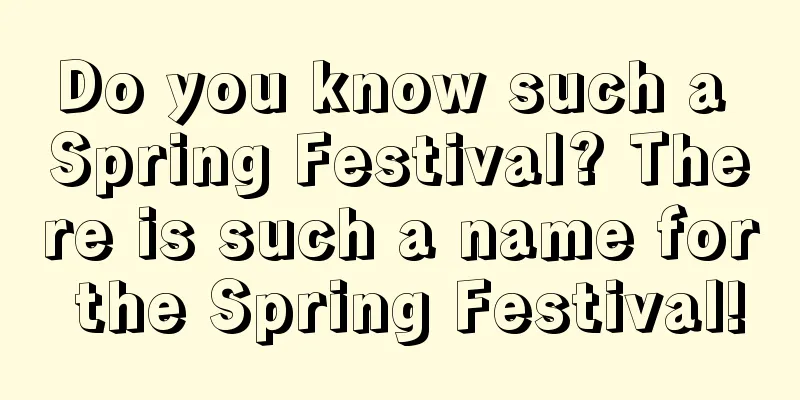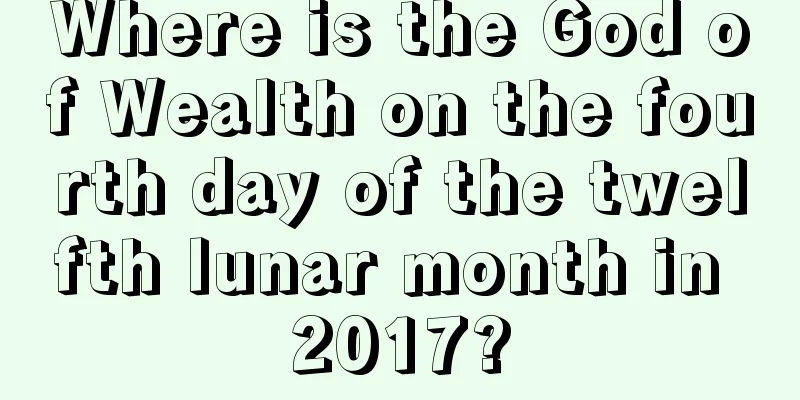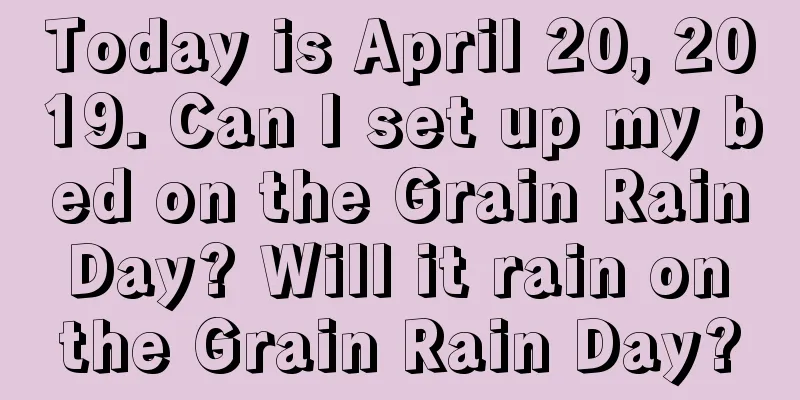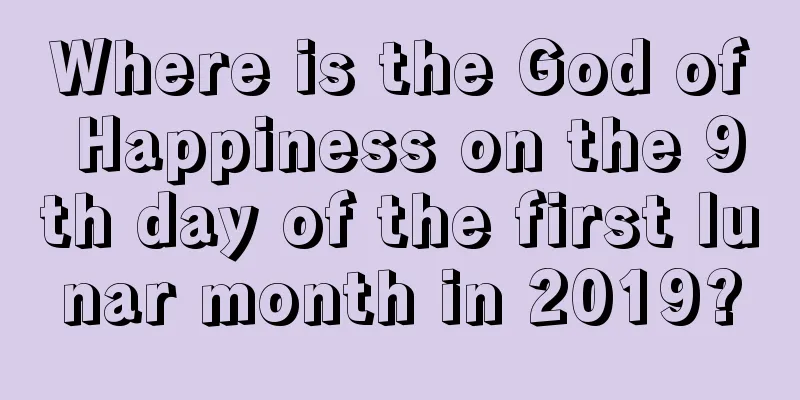Do you know such a Spring Festival? There is such a name for the Spring Festival!

Introduction: The Spring Festival is one of the four major traditional festivals in my country and one of the most important festivals for us Chinese. It has a history of more than 4,000 years. Over such a long historical course, the Spring Festival has undergone many changes and developments in its name and customs. Did you know that the Spring Festival has some other names? Come and find out with the editor! There is no end to the topics about the Spring Festival, so do you want to know more about it? Just continue to wander in Mr. Shui Mo’s Spring Festival special ocean!Various names of Spring FestivalWe all know that time can change many things. For example, clothing is different in every dynasty, and the same goes for festivals. The Spring Festival has different names in different eras. In the Pre-Qin period, it was called "Shangri", "New Year's Day", "Gaisui", "Xiansui", etc.; in the Han Dynasty, it was called "Sanchao", "Suidan", "Zhengdan", "Zhengri"; in the Wei, Jin, Southern and Northern Dynasties, it was called "Yuanchen", "New Year's Day", "Yuanshou", "Suichao", "Sui Shou", etc.; in the Tang, Song, Yuan and Ming Dynasties, it was called "New Year's Day", "Yuan", "Sui Ri", "Xinzheng", "Xinyuan", etc.; and in the Qing Dynasty, it has always been called "New Year's Day" or "New Year's Day".Introduction to Spring FestivalThe Spring Festival is China's most distinctive traditional festival. Chinese people have celebrated the Spring Festival for more than 4,000 years. There are many different theories about the origin of the Spring Festival, but the generally accepted one is that the Spring Festival originated in the Yu Shun period. The Spring Festival generally refers to the first day of the first lunar month, which is the first day of the year, also known as the lunar year, commonly known as "New Year's Day"; but among the people, the traditional Spring Festival refers to the period from the La Festival in the twelfth lunar month or the Kitchen God Festival on the twenty-third or twenty-fourth day of the twelfth lunar month, to the nineteenth day of the first lunar month, with New Year's Eve and the first day of the first lunar month as the climax. During the Spring Festival, China's Han ethnic group and some ethnic minorities hold various activities to celebrate. The main contents of these activities are to worship ancestral gods, pay tribute to ancestors, get rid of the old and welcome the new, welcome the new year and pray for a good harvest. The activities during the Spring Festival are rich and colorful, with strong ethnic characteristics. Influenced by Chinese culture, some countries and ethnic groups belonging to the Chinese character cultural circle also have the custom of celebrating the Spring Festival.Traditional name for the Spring FestivalIt means New Year, the Big Year, or the New Year, but it is also called “Dusui”, “Qingxinsui”, or “Guonian” verbally. In ancient times, the Spring Festival specifically referred to the Beginning of Spring in the solar terms, and was also regarded as the beginning of the year. Later, it was changed to the first day of the first lunar month as the New Year. Generally, the New Year does not end until at least the fifteenth day of the first lunar month (the Lantern Festival). The Spring Festival, commonly known as the "New Year's Festival", is the most important traditional festival of the Chinese nation. Before the period of Emperor Wu of Han, the dates of the Spring Festival were not consistent in different dynasties. Since the first year of Emperor Wu of Han, the first month of the Xia calendar (lunar calendar) was used as the beginning of the year, and the date of the New Year's Festival has been fixed and has continued to this day. After the 1911 Revolution of 1911, the Gregorian calendar was adopted to count years, and January 1 of the Gregorian calendar was called "New Year's Day", and the first day of the first lunar month was called "Spring Festival". Seasonal festivals, also known as "traditional festivals", have a long history and are widely spread. They are extremely popular, mass and even national. The New Year's Festival is a day to get rid of the old and start the new. Although the New Year's Festival is set on the first day of the first lunar month, the activities of the New Year's Festival are not limited to this day. Starting from the Minor New Year’s Day on the 23rd (or 24th) day of the 12th lunar month, people begin to prepare for the New Year: sweeping the house, washing hair and bathing, preparing New Year’s utensils, etc. All these activities have a common theme, which is “saying goodbye to the old and welcoming the new.” The New Year Festival is also a day for offering sacrifices and praying for a good harvest. The ancients called the ripening of millet a "year" and a bumper harvest of grains a "great year." In the early Western Zhou Dynasty, there were already annual activities to celebrate the harvest. Later, offering sacrifices to heaven and praying for a good harvest became one of the main contents of the New Year customs; moreover, various gods such as the Kitchen God, the Door God, the God of Wealth, the God of Joy, the God of Wells, etc., were all worshipped by people during the New Year period. People use this to thank the gods for their care in the past and pray for more blessings in the new year. The New Year's Day is also a time for family reunions, family gatherings and ancestor worship. On New Year’s Eve, the whole family gathers together, eats the “family reunion dinner”, the elders distribute “lucky money” to the children, and the whole family sits together to “stay up all night”. At the beginning of the new year on the first day of the lunar year, firecrackers are set off, and the activities of bidding farewell to the old year and welcoming the new year reach their climax. Each family burns incense to pay tribute to heaven and earth and to their ancestors, then greets their elders in turn, and then congratulates each other with relatives and friends. The New Year is also a festival for people to have fun and have fun. After the New Year's Day, various colorful entertainment activities are carried out: lion performances, dragon lantern dances, yangko dances, stilt walking, juggling performances, etc., adding a strong festive atmosphere to the Spring Festival. Therefore, the grand New Year festival that combines praying for a good harvest, celebration and entertainment has become the most important festival of the Chinese nation. Today, except for the fact that activities such as worshiping gods and ancestors have become less popular than before, the main customs of the New Year have been inherited and developed intact. In fact, the culture of a country can be reflected from its festivals. Usually festivals are a part of national culture. The Spring Festival is an important carrier of the excellent traditions of Chinese national culture. It contains the wisdom and crystallization of Chinese national culture, embodies the life pursuits and emotional sustenance of the Chinese people, and inherits the social ethical concepts of the Chinese people. Therefore, we must vigorously promote the excellent traditional culture condensed by the Spring Festival, highlight the themes of bidding farewell to the old and welcoming the new, blessings, reunion and peace, prosperity and development, etc., and strive to create a festive atmosphere of family harmony, stability and unity, joy and peace, and promote the enduring and continuous development and growth of Chinese culture. Summary: In fact, we often celebrate various festivals, but we don’t know much about the origins and backgrounds of these festivals. The Spring Festival is our grandest festival. After reading the above content, do you have a better understanding of the Spring Festival? I hope everyone can have a happy and peaceful Spring Festival!After reading this article, there are more exciting content in the Spring Festival special topic, let’s take a look! |
Recommend
Query the position of the God of Happiness on the 24th day of the 10th lunar month in 2018
The ninth month of the lunar calendar has passed,...
What day is August 15th in the lunar calendar 2017? Mid-Autumn Festival? What are the customs?
Introduction: In our country, we attach great impo...
Is November 30, 2017 a good date to open a new store or company?
In the eleventh month of the lunar calendar, whet...
When is Cold Food Festival in 2020? Is it an auspicious day?
Cold Food Festival is the only traditional Han fes...
What are the taboos during the Xiaoxue solar term? Is Xiaoxue an auspicious day in 2021?
Each solar term has corresponding taboos that cann...
Is it a good idea to get a haircut on the first day of October in the lunar calendar in 2020? Is it an auspicious day?
Is it a good idea to get a haircut on the first da...
Where is the God of Wealth on the fourth day of the tenth lunar month in 2019?
Where is the God of Wealth on the fourth day of t...
What is the zodiac sign for people born on November 17, 2017 in the lunar calendar? Keep working hard?
Introduction: In life, every day has its unique me...
What activities can be held on Mother's Day? What are the auspicious and unlucky times for Mother's Day on May 10, 2020?
Introduction: There are also many traditional cult...
Is it suitable to decorate the house on April 20 and May 12, 2020, Nurses' Day?
Introduction: It is also necessary to choose an au...
A list of auspicious days for getting married in the first month of the Year of the Pig 2019!
Getting married is a happy event and one of the mo...
What time is the Minor Cold in 2019? What date is Xiaohan in the lunar calendar?
2019 has arrived quietly, so when is the Minor Col...
Who are the great men and celebrities born on the Spring Equinox? Is a person born on the Spring Equinox in 2019 a pure Yin person?
Introduction: The Spring Equinox is an important s...
Does the autumnal equinox mean that half of autumn is over? When is the Autumnal Equinox in 2020?
The Autumnal Equinox is also a solar term in autum...
Introduction to taboos on placing fish tanks. Where should fish tanks not be placed?
The influence of different locations of fish tanks...









